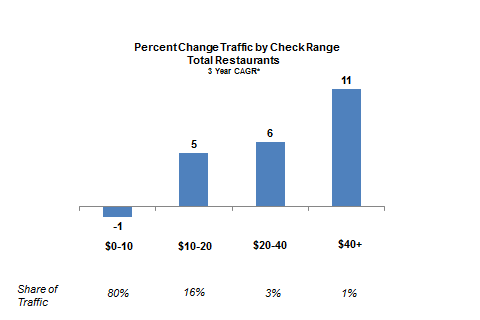As the gap between high- and low-income groups in the U.S. grows wider, the restaurant industry is feeling the pangs of stagnant traffic. A new report from The NPD Group, a global information company, found industry-wide traffic was flat while the fine-dining segment alone saw an increase in traffic between June 2013 and June 2014.
“Visits where consumers pay between $0 and $10 are declining—and that accounts for 80 percent of the industry,” says Bonnie Riggs, NPD’s restaurant industry analyst. “Even though the recession was declared over in June of 2010, consumers have not behaved in that manner or felt the recession was over. They got hurt very badly. It’s been a very slow recovery.”
What we’re seeing in today’s economy is income bifurcation, Riggs says. Less Americans are likely to identify themselves as middle class today compared to the years before the end of the recession. Riggs points to a poll conducted by the Pew Research Center in January of 2014 that found only 44 percent of Americans self-identify as middle class, compared to 53 percent in 2008, as proof of the lasting impact of the recession.
This income bifurcation, combined with a climate of high unemployment rates and dismal consumer confidence, has created a more cautious consumer.
“They will spend, but when they do, they expect to get what they pay for,” Riggs says.
Though fine-dining visits may be on the rise, that 80 percent of the industry is seeing no growth is problematic, she says. The heaviest users of quick-service restaurants, low-income consumers, were most affected by the recession and have cut back on restaurant visits. For quick-serve operators to survive the stagnation, they will have to appeal to more consumers in the shrinking middle class and those with higher incomes, Riggs says.
“It’s not just about the price being paid; it’s about the experience,” she says. “If you take a look at fast casual, and that segment continues to do well, because it’s not about the lowest price, but it’s fresh food. They get high markings for meeting consumer expectation, but they don’t visit nearly as often as they do fast food.”
By Tamara Omazic

